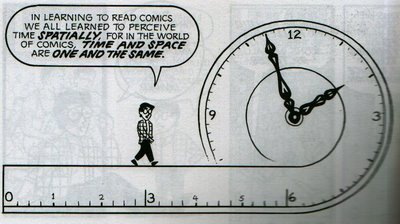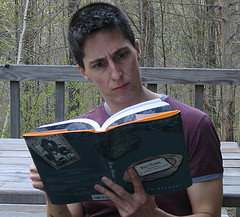Serendip is an independent site partnering with faculty at multiple colleges and universities around the world. Happy exploring!
Towards Day 5: Having Fun @ Home

Discussion Notes by jaranda

I. coursekeeping
* naming one another
* signing-in sheet
* signing-up TWICE to take notes on class conversations (Amanda, Jacklyn, EmilyT, Marina, Julia only once--but on for today?);
* coming for a writing conference this week
(missing Amanda, Maggie, Rachel, SandraM?)
* papers due by 5 p.m. this Friday
* instructions for preparing and posting your webpaper-as-a-blog/portfolio (NOT in the course forum) @ top of home page
* finish reading Fun Home for Thursday's class
![]()
II. two points about the "reality
check" that was Reality Hunger:
1. oxymoronic argument
("oxymoron" comes from the Greek word ὀξύμωρον, meaning "sharp dull"; a figure of speech combining the normally contradictory)
that our search for the real paradoxically reveals its constructedness,
its fragility,
its revisability; in short,
its "fictionality."
maht91: any piece of writing is a craft of art
Owl: don't we all fight to not be confined to the one definition that is given to us?
It is a shaping and selecting out of what William James called our confrontation with the "blooming buzzing mass of confusion before us," where (James argued) attention to outward stimuli is largely a function of personal interest.
In "facing the facts" (this argument goes), we organize the world around ourselves, to suit our needs (we're going to see, in a moment, how well that description works for Bechdel's graphic autobiography). Some of us were troubled by this idea--
maht91: our memory is selective .... we choose consciously or unconsciously to omit certain aspects of our memory when we speak .... it made me doubt the real aspects of books that I previously read.
2. But another (possibly more hopeful?) response to this idea that facts are constructions is to do what Shields does repeatedly: to emphasize their common sources (and to begin to think about how to reconceive property as a shared resource, rather than as an individual creation). The argument is not that there is no intellectual property, but rather that it is owned by all of us.
jaranda: his point that nothing is original....Once ... the amount of quoting Shields was actually doing became apparent, I feel like it was harder to take him seriously.
For much more on taking this idea seriously, see
both the two links platano put up, and also Lewis Hyde's brand-new book, Common as Air: Revolution, Art and Ownership.
![]()
@ BarnesandNobleReview.com , you'll find one of Ward Sutton's marvelous "Drawn to Read" reviews of Hyde's book: http://bnreview.barnesandnoble.com/t5/Drawn-to-Read/Common-as-Air/ba-p/3167
Those of you thinking about the implications for copyright, etc. of Shields' mash-up of the factual and fictional, the privately owned and the publicly owned should look @ Hyde's book; on p. 14, for example, he lists a whole range of projects that conceive of themselves as cultural commons (or breeding grounds for them):
Project Gutenberg
Wikipedia
Knowledge Conservancy
Internet Archive
Public Library of Science
Creative Commons
Science Commons
Neurocommons....
In "Literary Kinds" last semester, we looked also @ some related material, w/ a particular focus on the humanities:
The Digital Humanities Manifesto 2.0
A Digital Humanities Manifesto
Beyond the Dissertation Monograph
Planned Obsolescence: Publishing, Technology and The Future of the Academy
these are all sites for further study/possible sources for further exploration, for your papers...
III. But first, another sort of (tragi?)fun...
![]()
your initial reactions:
FatCatRex's report from this as concluding text in "Women's Life Writing" last spring:
many literary parallels and references work to create an air of authenticity and depth .... even if the version of the story sans those references is the Truth with a capital T, isn't the 'truth' with the tale of Icarus and the Ulysses reference, much more compelling..?
... there is so much to be said about the layers of truth and non-truth in this piece--not the least of which is around the parallel sexualities of Alison and her father. The death of one coinciding with the beginning of the other's life (as an out human being)...Its a pretty incredible story, fully true or not, seems not to matter because the overall effect is so powerful. For me at least, this is a story in which I do not what to know if some details have been fudged or switched to align appropriately--instead, I just want to read and re-read this and bask in the glow of its prose, fiction or non.
how does reliance on fictional sources increase authenticity? (cf. veritatemdelixi's refusal to accept Hamlet as a source for moral reasoning...?)
when/why does "the truth/Truth" matter to us?
kgould on Graphic Novels and Joyce course as contexts for reading Bechdel: Bechdel is, in her own way, an artificer, going to great lengths to recreate the layout of her house, the patterns in the wallpaper (check out page 60), the reappearance of Sunbeam Bread all throughout the novel, the use of greek mythology, and all of the little facets and illusions she gives to James Joyce's work, Ulysses, from which Fun Home is shaped.

IV. my questions:
how's this book work as non-fictional prose?
what, in particular, does making it "graphic"
do to-or-with the genre?
Some Theoretical Resources for reading Graphic Narratives (w/ apologies to rachelr and mkarol)

"To grasp the essence of comics I think it's helpful -- to begin seeing comics as this. An artist's map of time itself." (Scott McCloud, via ShaynaS)
Scott McCloud's describes the difference between easily PERCEIVED images and words, which need more work to be RECEIVED (=decoded). Is this an accurate description of your own experience?
![]()
Other critical sources on graphic narrative as a genre:
Derek Parker Royal "Introduction: Coloring America; Multi-Ethnic Engagement with Graphic Narrative." MELUS 32, 3 (Fall 2007): 7-22.
visual language: more immediate processing time and more "efficient exchange between author(s) and audience
heavily coded medium, rely on stereotyping
broader, more abstract a figure: closer we come to identifying with it
time is spacialized in graphic narrative
comics' spatio-topical system foregrounds relational perspective:
word balloons, frame of individual panels, gutter ("blank" space between panels),
strip (horizontal ban of panel arrangement), page layout
graphic narrative best term to capture most permutations of comics
Annalisa Castaldo "No More Yielding than a Dream," College Literature 31, 4 (Fall 2004): 94-100.
equal weight to text and images, providing both immediate effect and intellectual engagement
because drawn: illustrate the fantastic and unreal more effectively
leads to persistent metatextuality, as characters regularly cross over into other universes
continuing series, which allows for slow unfolding of ideas
Richard Walsh, "The Narrative Imagination Across Media." Modern Fiction Studies 52, 4 (2006): 855-868.
Narrative cannot be medium-independent: it is always dependent on representation in some medium.
dreaming is a "first draft of thought"..."the dream can't revise"...is a sequential, recursive process...
can be understood as ... the proto-fiction
Scott McCloud, The Form of a Webcomic --
in the form of a webcomic!
"Shouldn't stories dictate the shape our comics take, and not the other way around?
...a new form of sequential art...that recaptures comics' pre-print ancestor..."
think about graphic narratives as contemporary forms of medieval illuminated manuscripts...
...and keep on reading with this in mind....

Come also on Thursday prepared to do a "close reading" of a couple of frames--explain to us what is going on here, as text and image work with and against one another....
Discussion Notes by jaranda


